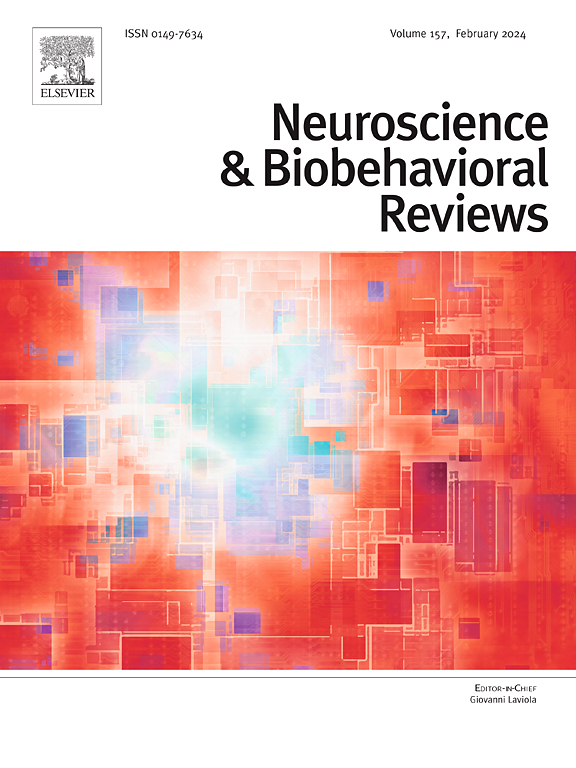Amygdala hyperactivation in childhood maltreatment: An ALE-based meta-analysis on emotion-related processing
IF 7.5
1区 医学
Q1 BEHAVIORAL SCIENCES
引用次数: 0
Abstract
Childhood maltreatment (CM), encompassing various forms of abuse and neglect, is associated with adverse developmental outcomes and heightened risk for psychiatric conditions. Functional magnetic resonance imaging (fMRI) studies point to altered neural responses during tasks involving emotion-related processing in maltreated individuals, yet inconsistent findings have limited the field’s ability to draw clear conclusions about the loci of altered brain function. This meta-analysis aimed to synthesize existing task-based fMRI data on emotional processing in individuals with a history of childhood maltreatment, with particular emphasis on identifying consistent patterns of hyperactivation compared to non-maltreated controls. A systematic search following the Preferred Reporting Items for Systematic Reviews and Meta-Analyses (PRISMA) guidelines across Web of Science, Scopus, PubMed, and PsycInfo identified 674 studies, of which 30 met the inclusion criteria. Using the Activation Likelihood Estimation (ALE) method, the meta-analysis incorporated 368 brain coordinates (foci) and 93 contrasts from experiments involving 2474 participants (1169 in the maltreatment group and 1305 in the control group). The ALE analysis identified a robust cluster of hyperactivation in the right amygdala in maltreated individuals during emotional processing tasks. Peak activation was observed at [20, –4, –16], suggesting heightened threat detection and emotional reactivity in those with a history of childhood maltreatment. No significant clusters emerged for increased activation in the control group. These findings underscore the amygdala's central role as a neural substrate affected by childhood maltreatment, contributing to heightened emotional reactivity and dysregulated emotion-related processing in affected individuals.
儿童虐待中杏仁核过度激活:基于ale的情绪相关加工meta分析
儿童虐待(CM),包括各种形式的虐待和忽视,与不良的发育结果和精神疾病的风险增加有关。功能性磁共振成像(fMRI)研究指出,在受虐待的个体中,在涉及情绪相关处理的任务中,神经反应发生了改变,但不一致的发现限制了该领域对大脑功能改变位点得出明确结论的能力。本荟萃分析旨在综合现有的基于任务的功能磁共振成像数据,这些数据是关于有童年虐待史的个体的情绪处理,特别强调与未受虐待的对照组相比,识别一致的过度激活模式。在Web of Science、Scopus、PubMed和PsycInfo中,根据系统评价和荟萃分析(PRISMA)指南的首选报告项目进行了系统搜索,确定了674项研究,其中30项符合纳入标准。采用激活似然估计(ALE)方法,meta分析纳入了来自2474名参与者(虐待组1169人,对照组1305人)的368个脑坐标(foci)和93个对比。ALE分析发现,在受虐待的个体进行情绪处理任务时,右侧杏仁核有一个强大的过度激活簇。峰值激活在[20,-4,-16]被观察到,这表明那些有童年虐待史的人有更高的威胁检测和情绪反应。在对照组中没有明显的集群出现增加的激活。这些发现强调了杏仁核作为受儿童虐待影响的神经基质的核心作用,有助于受影响个体的情绪反应增强和情绪相关处理失调。
本文章由计算机程序翻译,如有差异,请以英文原文为准。
求助全文
约1分钟内获得全文
求助全文
来源期刊
CiteScore
14.20
自引率
3.70%
发文量
466
审稿时长
6 months
期刊介绍:
The official journal of the International Behavioral Neuroscience Society publishes original and significant review articles that explore the intersection between neuroscience and the study of psychological processes and behavior. The journal also welcomes articles that primarily focus on psychological processes and behavior, as long as they have relevance to one or more areas of neuroscience.

 求助内容:
求助内容: 应助结果提醒方式:
应助结果提醒方式:


